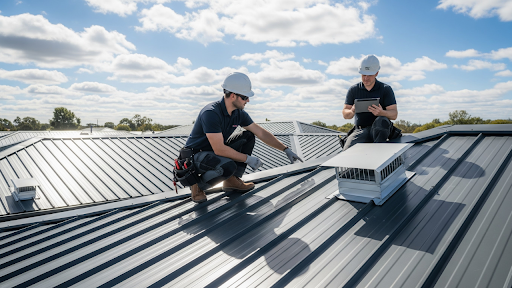A metal roof does more than protect your home—it regulates temperature, prevents moisture buildup, and boosts energy efficiency. However, all of that only works when the system is functioning correctly. Understanding how metal roofs are vented helps homeowners comprehend why proper airflow isn’t optional—it’s essential for comfort, durability, and lower energy costs.
Understanding Why Ventilation Matters
Every roof traps heat and moisture, especially in hot or humid climates. Without proper ventilation, that buildup can cause condensation, mold, and damage to the roof deck over time.
For metal roofing, airflow keeps the temperature stable between the attic and outside air. It reduces stress on the panels, prevents warping, and improves insulation performance. In short, good ventilation means a longer-lasting roof and a more comfortable home year-round.
The Key Components of a Ventilation System
Professional roofers design ventilation systems using two main parts: intake vents and exhaust vents.
- Intake vents (usually at the eaves or soffits) let fresh air enter beneath the metal panels.
- Exhaust vents (placed near the ridge or roof peak) allow hot, moist air to escape.
When both are installed correctly, they create a balanced airflow cycle that naturally draws out heat and moisture. The goal is to maintain consistent circulation so no part of your attic becomes a “hot spot.”
Ventilation Options for Metal Roofs
Experts choose different systems depending on roof design, slope, and insulation type.
- Ridge vents: Installed along the peak of the roof for seamless, natural exhaust airflow.
- Gable vents: Positioned on exterior walls to increase cross-ventilation.
- Soffit vents: The most common intake type, drawing cool air from under the eaves.
- Mechanical vents: Used when natural airflow isn’t enough—fans actively push out hot air.
For low-slope or flat metal roofs, choosing the best ventilation for metal flat roof systems often involves a combination of mechanical vents and specialized insulation layers. These prevent trapped air pockets and keep indoor temperatures stable even under direct sunlight.
How Experts Design a Balanced System
Professionals start with an attic inspection to measure moisture levels, insulation density, and roof shape. Then, they calculate ventilation needs using building code formulas—typically requiring 1 square foot of vent area per 300 square feet of attic space.
Roofers also check for any obstructions like insulation blocking soffit vents or debris in ridge caps. Once everything is clear, vents are installed strategically to maximize cross-flow while keeping the roof watertight. The balance is key: too few vents trap heat, too many vents waste energy and compromise structure.
Common Ventilation Mistakes to Avoid
DIY roof installations often overlook proper airflow. Sealing vents too tightly, skipping soffit openings, or using mismatched systems can trap humidity instead of releasing it. Over time, this leads to corrosion, rust stains, and insulation damage beneath the panels.
That’s why homeowners should always rely on trained roofing specialists. Professionals ensure every layer—from underlayment to ridge vent—is properly integrated to maintain both efficiency and aesthetics.
Conclusion
Proper ventilation is what transforms a strong roof into a smart one. When experts understand exactly how metal roofs are vented, they can create a system that keeps your home cool, dry, and durable year-round. From ridge vents to soffit designs, the right balance of intake and exhaust ensures your metal roof performs at its best. And when you choose systems that offer the best ventilation for metal flat roof types, you invest in comfort, longevity, and peace of mind.


